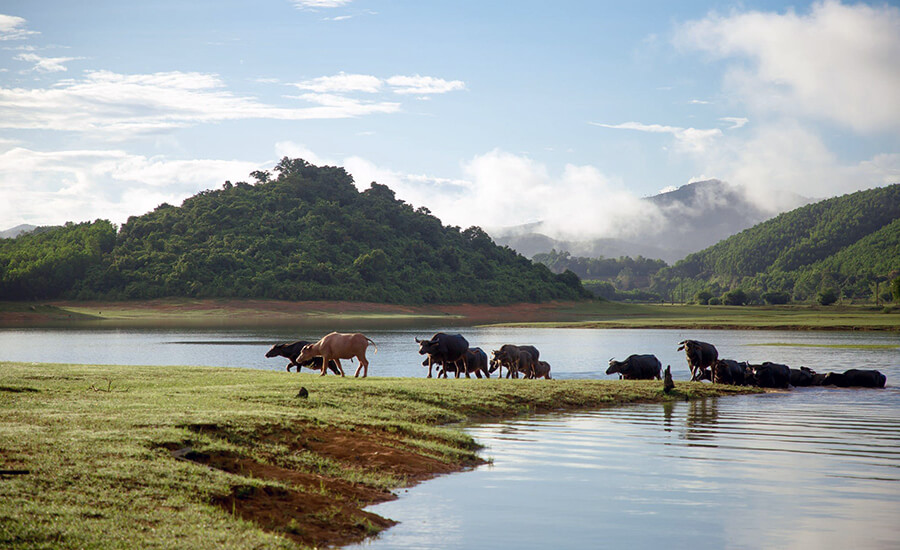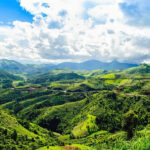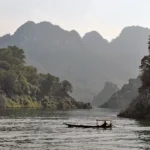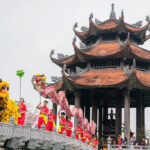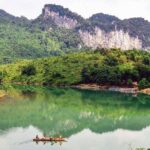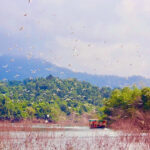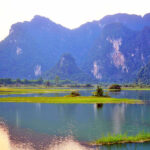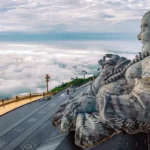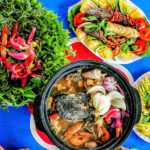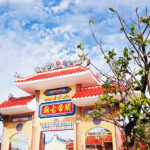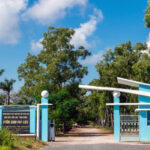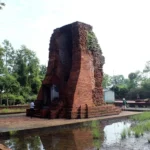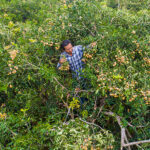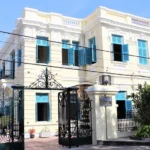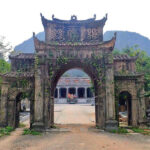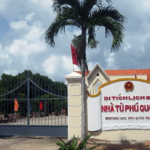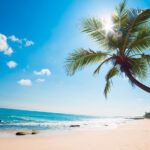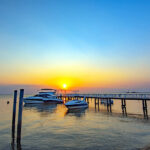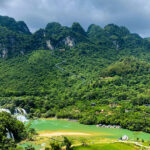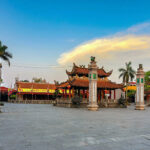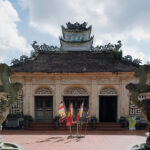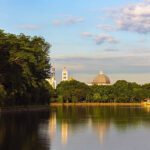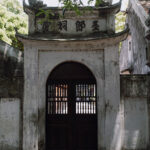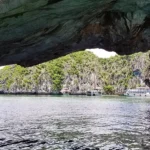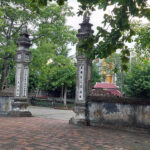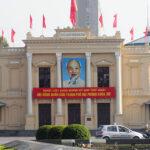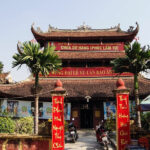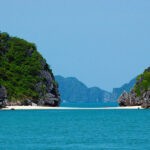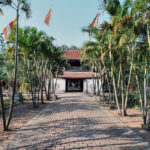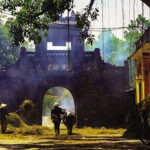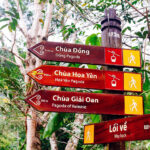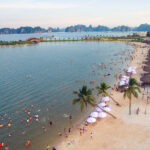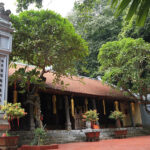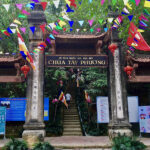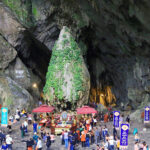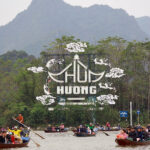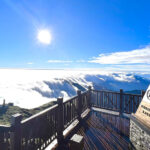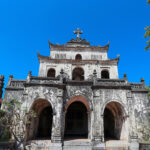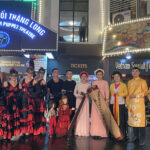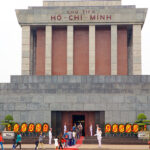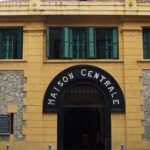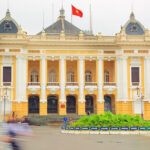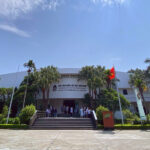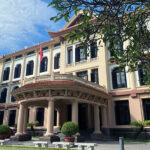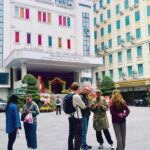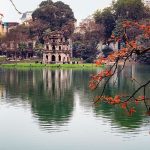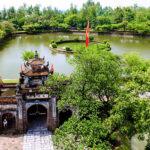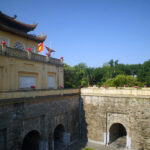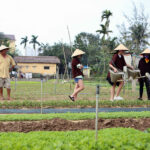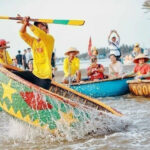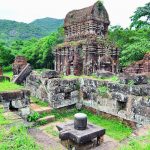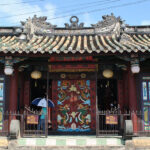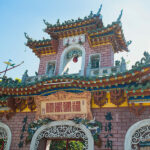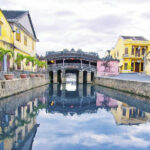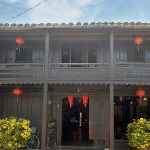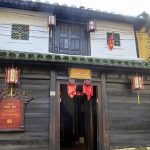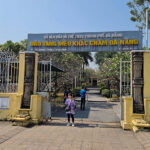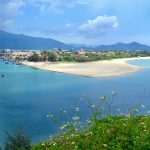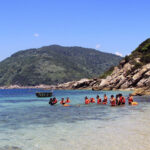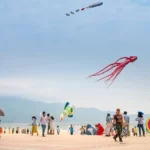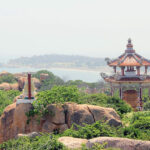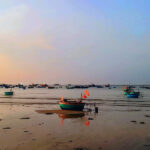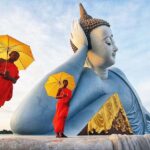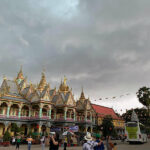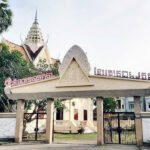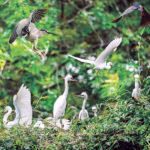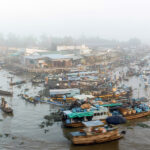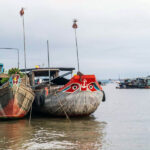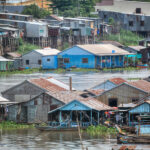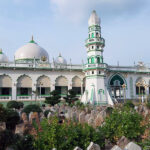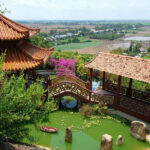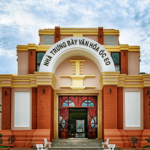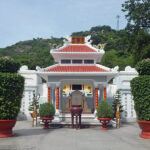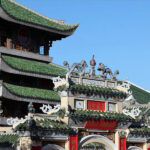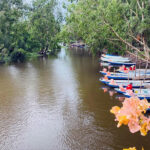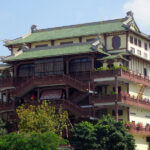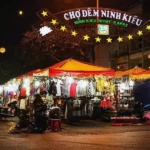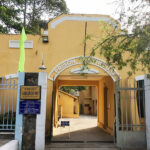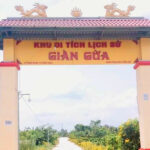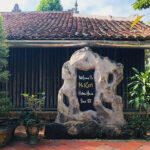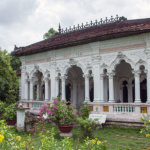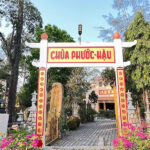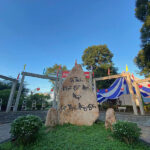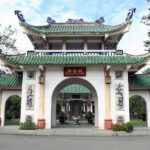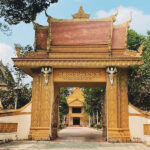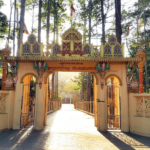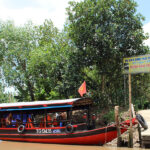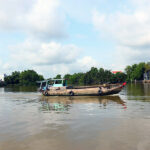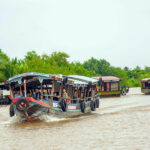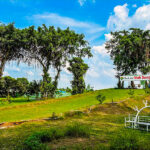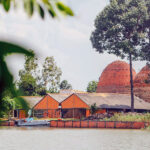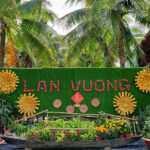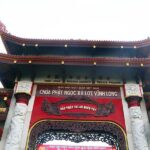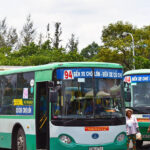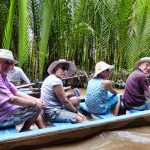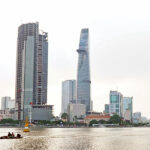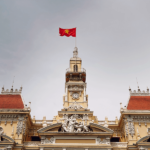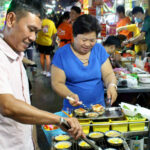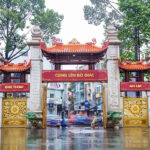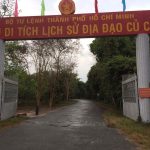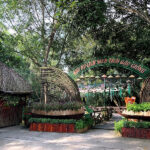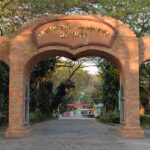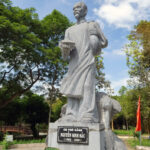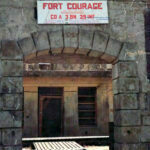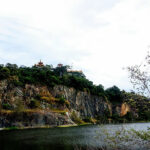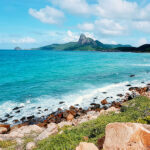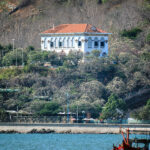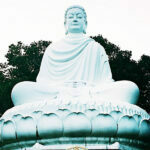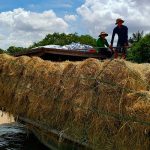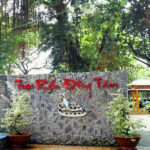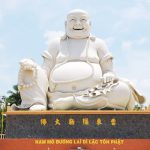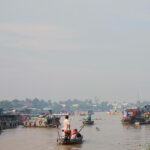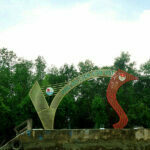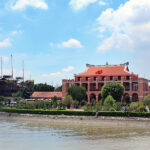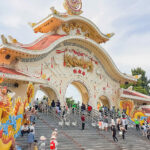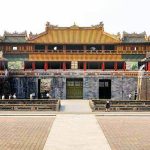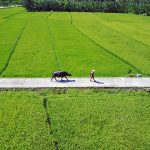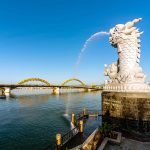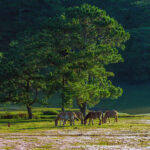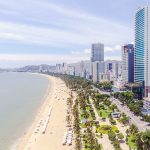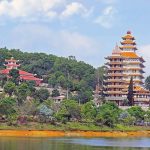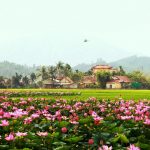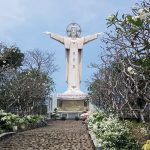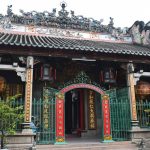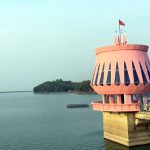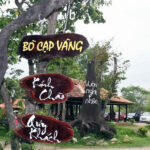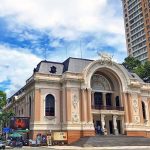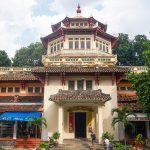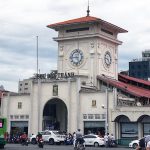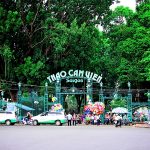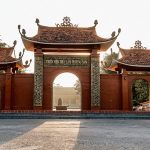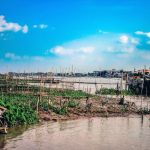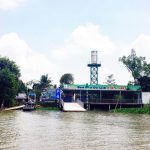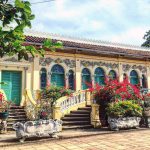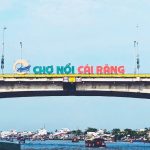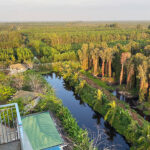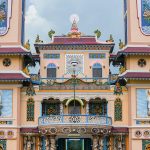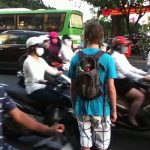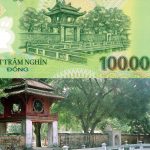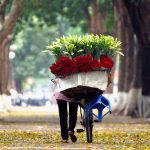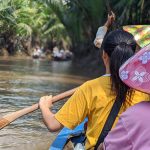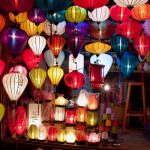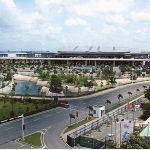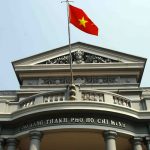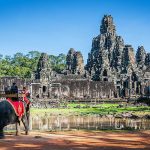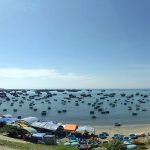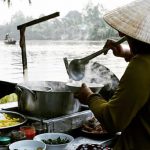Thanh Hoa is a locality in the North Central region, considered a “miniature Vietnam” with cultural and historical values combined with natural values such as forests, mountains, seas, streams, rivers, lakes… This is the foundation for creating many products of sea tourism, cultural tourism, spiritual tourism, eco-tourism, resort tourism, discovery tourism… attracting a large number of tourists to visit and relax.
Table of Contents
General information about Thanh Hoa
Thanh Hoa city is 160 km south of Hanoi, 1,562 km north of Ho Chi Minh City. The province is located in the northernmost part of the Central region, has a border with Laos and a coastline in the Gulf of Tonkin of 102 km long with many different ecological zones.
What’s the best time to visit Thanh Hoa?
Thanh Hoa has two distinct seasons. The hot season starts from May to October, with strong sunshine, heavy rain and frequent storms and floods, with an average temperature of 38-40 degrees Celsius. The cold season is from November to April, with the Northeast monsoon, little rain and dry weather at the beginning of the season. The lowest temperature can drop to 2 degrees Celsius.
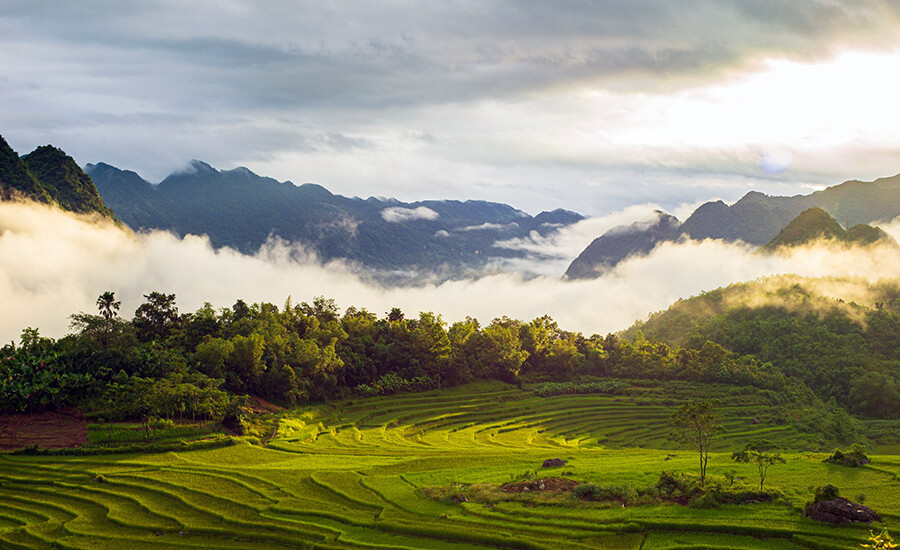
A view at Pu Luong, Thanh Hoa (photo: collected).
The best time to travel to Thanh Hoa is from March to August. Summer is suitable for visiting famous beaches. Autumn is cool, suitable for vacations. At this time, the number of tourists also decreases, and service prices are more stable than during peak season.
How to get there?
Visitors can come to visit Thanh Hoa by many means such as train, motorbike, bus or plane, depending on the departure location.
The price of Thong Nhat train tickets from Hanoi ranges from 140,000 to 280,000 VND per ticket depending on the seat class and train type. This is a way to save money and enjoy the scenery along the way.

Inside the soft seat cabin of the train to Thanh Hoa.
If using a private car from Hanoi to Thanh Hoa, there are two routes: National Highway 1A Hanoi – Ninh Binh – Thanh Hoa or Phap Van – Cau Gie – Ninh Binh – Thanh Hoa expressway. From the end of April 2023, the Mai Son – National Highway 54 connecting the two provinces of Ninh Binh – Thanh Hoa will help travel from Hanoi to about 2 hours.
There are many bus companies operating from Hanoi to Thanh Hoa. Tourists can buy tickets at My Dinh or Giap Bat bus stations for prices ranging from 150,000 VND to 200,000 VND per ticket.

Inside a sleeler-bus to Thanh Hoa.
Ho Chi Minh City is more than 1,400 km from Thanh Hoa. For tourists from the southern provinces, airplanes are the most convenient means of transportation, landing at Tho Xuan airport. The round-trip ticket price of Vietnam Airlines, Vietjet Air is about 2-3 million VND, flight time is nearly 2 hours.
To get to the city center, visitors can take a taxi, a shuttle bus or a bus. The three largest taxi companies are Mai Linh, MeKong and Taxi 36. In addition, Thanh Hoa also has local buses.
Accommodation in Thanh Hoa
Some hotels located in the center of Thanh Hoa city are Muong Thanh Grand Hotel, Melia Vinpearl Thanh Hoa, Phu Hung Hotel, Central Hotel, Phuong Hoang Hotel… Here, it is easy to get to tourist attractions in the city center. The average room rate is from 600,000 VND to more than 1 million VND per night.

A resort in Thanh Hoa (source: booking)
Hotels and motels at some beaches and tourist areas have higher prices. In Sam Son, if you are looking for a place to stay near the sea with a beautiful view, you can refer to the system of hotels, resorts and private villas at FLC, Van Chai resort; in Hai Tien there is Paracel resort, Moonlight Hotel, Hai Tien resort, Eureka Linh Truong; in Bai Dong there is Nghi Son Eco Island… Room rates range from 800,000 VND to about 4 million VND per night.
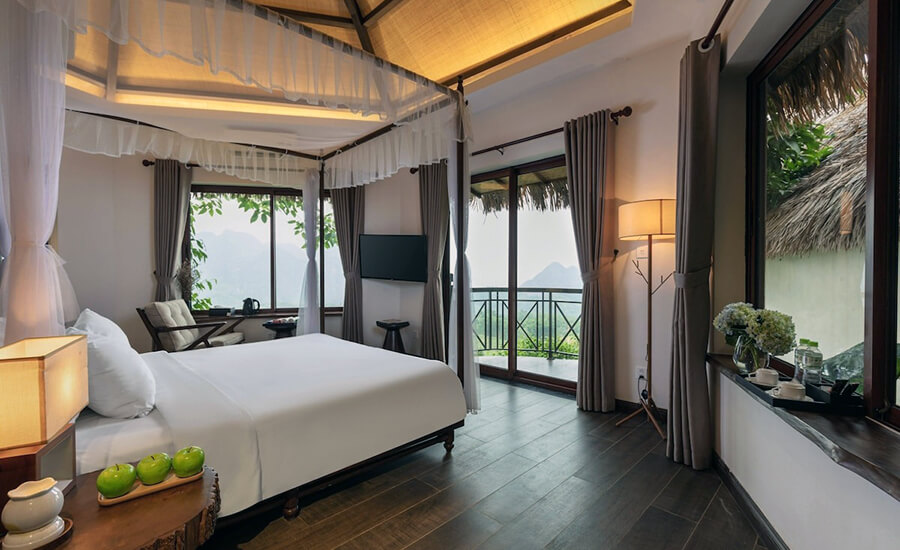
(photo source: booking)
In addition, visitors can also choose budget motels in the city center or districts, with full basic amenities. Motel prices in Thanh Hoa are about 300,000 VND per night or more.
Tourist attractions in Thanh Hoa
Thanh Hoa has rich tourism resources with many scenic spots, historical sites, beaches, primeval forests, cave systems and limestone mountains spread across the wards of the province and many famous festivals.
A famous tourist destination in Thanh Hoa is Sam Son beach. Every year, the beach attracts a large number of tourists, especially during the April 30 holiday and summer.
The best beaches
Sam Son Beach
Located 16km from central ward, Sam Son beach is an excellent location for bathing. The beach became a famous seaside resort in early part of the 20th century.
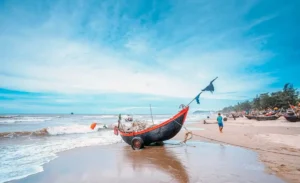 A number of villas were built on the beach before the first Indochina War, including one belonging to King Bao Dai, the last king of the Nguyen Dynasty.
A number of villas were built on the beach before the first Indochina War, including one belonging to King Bao Dai, the last king of the Nguyen Dynasty.
Besides the beaches, Sam Son offers scenic sports such as Trong Mai Rocks, Doc Cuoc temple and Mount Co Tien. Doc Cuoc Temple is erected on Co Giai Rock, on the Truong Le Mountain, next to Sam Son sea resort. It is a place of worship for the One-Legged Deity. According to legend, a young giant tore his body to fight at the same time a marine monster and enemies on land in order to protect to inhabitants of Sam Son. The latter decided to build a pagoda in his honour on a rock that bore a giant footprint. Built under the Tran Dynasty, the temple has been restored several times.
Every year, the beach attracts a large number of tourists, especially during the April 30 holiday and summer.
Hai Tien Beach
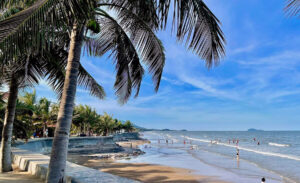 Located about 15 km northeast of Thanh Hoa center, Hai Tien has a long coastline, clean sand, pristine scenery but modern infrastructure, convenient services, suitable for relaxation. The gentle coastline with stable sand, moderate currents and no dangerous whirlpools. The slope of the coastline and wave level are also safe for tourists to swim. The biggest advantage of this tourist area is its proximity to historical and cultural relics of Thanh land.
Located about 15 km northeast of Thanh Hoa center, Hai Tien has a long coastline, clean sand, pristine scenery but modern infrastructure, convenient services, suitable for relaxation. The gentle coastline with stable sand, moderate currents and no dangerous whirlpools. The slope of the coastline and wave level are also safe for tourists to swim. The biggest advantage of this tourist area is its proximity to historical and cultural relics of Thanh land.
From the beach, visitors can go to Sam Son beach, Lach Hoi, the mangrove forest reserve, and Con Truong mangrove forest by yacht. In addition, visitors can participate in many activities on the beach, enjoy fresh seafood at affordable prices.
Dong Beach
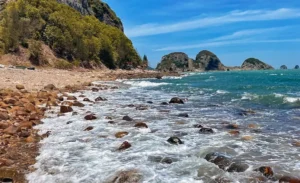 Dong beach is a destination in Nghi Son ward, about 40 km southeast of Thanh Hoa center. Clear sea water, fine sand, small waves, suitable for swimming and relaxation. Tourism services have begun to develop at Dong beach, but are not as diverse as other beaches in Thanh Hoa such as Hai Tien or Sam Son.
Dong beach is a destination in Nghi Son ward, about 40 km southeast of Thanh Hoa center. Clear sea water, fine sand, small waves, suitable for swimming and relaxation. Tourism services have begun to develop at Dong beach, but are not as diverse as other beaches in Thanh Hoa such as Hai Tien or Sam Son.
The air is fresh and quiet, suitable for tourists who want to avoid the noise and crowds of famous tourist destinations. This is a suitable place for camping overnight, watching the sunrise. Dong beach also has many bungalows and restaurants; enjoy fresh seafood caught daily. Later, tourists can go squid fishing, fishing, and have dinner with the fishing villagers.
Nature and wildlife areas
Pu Luong Nature Reserve
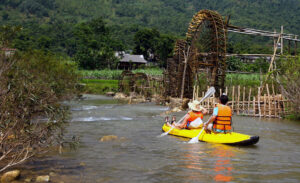 Pu Luong Nature Reserve is located at an altitude of 1,700 m, with cool weather, fresh air and a landscape close to nature. Pu Luong is home to the Thai and Muong ethnic communities. In Thai, Pu Luong means the highest peak of the village. Pu Luong is located in the northwest of Thanh Hoa province, with an area of 17,662 hectares, including dense forests, large and small waterfalls, caves and mountains interspersed with peaceful villages. Pu Luong has two rice harvest seasons in May and October every year, attracting many tourists. Coming to Pu Luong, visitors can conquer Pu Luong peak, visit Hieu village famous for Hieu stream, where tree roots in the stream are calcified into stone, Tom village, Don village, Bat cave…
Pu Luong Nature Reserve is located at an altitude of 1,700 m, with cool weather, fresh air and a landscape close to nature. Pu Luong is home to the Thai and Muong ethnic communities. In Thai, Pu Luong means the highest peak of the village. Pu Luong is located in the northwest of Thanh Hoa province, with an area of 17,662 hectares, including dense forests, large and small waterfalls, caves and mountains interspersed with peaceful villages. Pu Luong has two rice harvest seasons in May and October every year, attracting many tourists. Coming to Pu Luong, visitors can conquer Pu Luong peak, visit Hieu village famous for Hieu stream, where tree roots in the stream are calcified into stone, Tom village, Don village, Bat cave…
Ben En National Park
The Ben En National Park was established on January 27, 1992. This natural site spans across Xuan Thai commune, 36km southwest of Thanh Hoa center. The park is surrounded by hills and mountains. In the park stand out some mountains such as Bu Dang, Nui Truong, Bu Co, Bao Cu, Dam and Son.
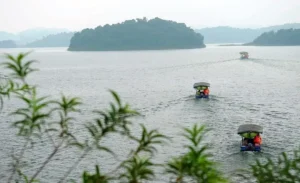 The average temperature during the year is 23°C, the average humidity is 85%. The park’s forest is 16.634 ha including 8,544 ha of primitive forest. There are also mountains, rivers, springs, lakes on mountains whose names are associated with legends and ancient tales.
The average temperature during the year is 23°C, the average humidity is 85%. The park’s forest is 16.634 ha including 8,544 ha of primitive forest. There are also mountains, rivers, springs, lakes on mountains whose names are associated with legends and ancient tales.
The park’s vegetation cover has two types of tropical forest, broad leaf green wood and semi-decidous. One can find here some rare plants and 870 tall plant species classified into 412 genera and 134 families. Some rare animals such as the red wolf, Tibetan bear, black gibbon, phoenix…live in the park.
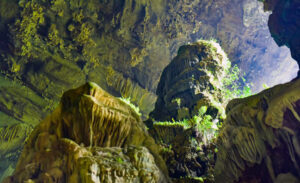 Muc lake covers an area of 3,000 ha in Ben En national park. This is a favourable environment for the development of fish species. On the higher lake, there are 21 large and small islands and a few islets with natural trees; and the lower lake borders mountains which have exotic and huge shapes, constituting a breath-taking landscape. Inside the Hai Van Mountain Range are caves such as Ngoc, Can, Doi (Bat) famous for their mystical and astounding stalagmites.
Muc lake covers an area of 3,000 ha in Ben En national park. This is a favourable environment for the development of fish species. On the higher lake, there are 21 large and small islands and a few islets with natural trees; and the lower lake borders mountains which have exotic and huge shapes, constituting a breath-taking landscape. Inside the Hai Van Mountain Range are caves such as Ngoc, Can, Doi (Bat) famous for their mystical and astounding stalagmites.
 People go to the Ben En national park to relax to live in harmony with nature to explore and to study rare animal species. They may have a good time to spend enjoying grilled fresh fish next to a brook. Given its great natural potential, the park is becoming an ideal destination for those interested in eco-tourism, sightseeing and scientific studies. At present, houses for tourists are being constructed, facilities for for pupils, students, tourists, and scientists have been set up for the purposes of studies and visits. For the locals, the parks is the first choice for outdoor activities at weekends.
People go to the Ben En national park to relax to live in harmony with nature to explore and to study rare animal species. They may have a good time to spend enjoying grilled fresh fish next to a brook. Given its great natural potential, the park is becoming an ideal destination for those interested in eco-tourism, sightseeing and scientific studies. At present, houses for tourists are being constructed, facilities for for pupils, students, tourists, and scientists have been set up for the purposes of studies and visits. For the locals, the parks is the first choice for outdoor activities at weekends.
With its natural landscape and its rich and precious flora and fauna. Ben En constitutes a great ecological tourist attraction.
Cam Luong Fish Stream
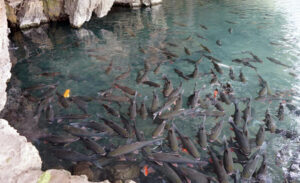 This site belongs to Ngoc Village, Cam Tu Commune, 80km west of Thanh Hoa center. The stream is unique because it contains thousands of fish that no one dares catch it. Fish in the stream have red mouth and fins, and brown scales, resembling carp. Each fish weighs from two to eight kilograms, particularly, the big ones can weight 30 kg. In the morning, schools of fish swim in the stream that comes from the cave. They swim back to the cave in the evening.
This site belongs to Ngoc Village, Cam Tu Commune, 80km west of Thanh Hoa center. The stream is unique because it contains thousands of fish that no one dares catch it. Fish in the stream have red mouth and fins, and brown scales, resembling carp. Each fish weighs from two to eight kilograms, particularly, the big ones can weight 30 kg. In the morning, schools of fish swim in the stream that comes from the cave. They swim back to the cave in the evening.
In addition to the fish stream, you can visit Cay Dang Grotto; the Ngoc Village of Muong ethnic people, watch dancing performances of Muong people, and enjoy traditional lam rice and can wine.
Historical and cultural relics
Ho Citadel
Ho Citadel, also called Tay Do Wall, is situated in Tay Do communes, approximately 150km from Hanoi. The citadel was erected in 1397, during the Ho Dynasty. The stone citadel was built in the shape of a rectangle and surrounded by a deep moat. Its walls were made of green granite.
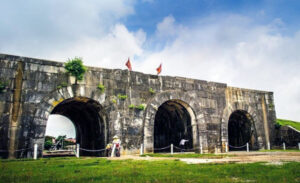 There are four gates on each side of citadel. The south wall had two small gates. From the South gate had stone road leading to the Nam Giao esplanade at Don Son.
There are four gates on each side of citadel. The south wall had two small gates. From the South gate had stone road leading to the Nam Giao esplanade at Don Son.
Upon completion of the wall, King Ho Quy Ly moved the capital from Thang Long to Tay Do. The citadel was eventually destroyed and abandoned. More than 6 centuries passed since the wall was erected, and only ruins of the South Gate remain.
Nowadays, inside the citadel are remains of foundations of the royal places and two carved stone dragons. The stone citadel is recognized by UNESCO as a world cultural heritage, and is one of the very few remaining stone citadels in the world.
Lam Kinh Remains
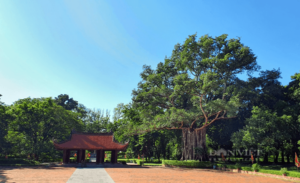 Lam Kinh Remains is located in Lam Son commune, which is he birthplace of Vietnamese hero Le Loi and starting point of the Lam Son revolutionary insurrection. It is 50km to the north-west of Thanh Hoa center. The Ministry of Culture recognized it as a historical site in 1962.
Lam Kinh Remains is located in Lam Son commune, which is he birthplace of Vietnamese hero Le Loi and starting point of the Lam Son revolutionary insurrection. It is 50km to the north-west of Thanh Hoa center. The Ministry of Culture recognized it as a historical site in 1962.
After Le Thai To was crowned and moved the capital to Dong Kinh (or Thang Long), he had the second biggest citadel built in his native land, Lam Son. The citadel is known as Lam Kinh or Tay Kinh citadel.
The northern part of the citadel leans against Mount Dau. Its southern part overlooks the River Chu, 900m from which is Mount Chua standing as the front obstruction. To the east of the citadel is the Phu Lam mountains and Mount Ngoc which look like an arrow. To the west are Mounts Huong and Ham Rong. The structures of the citadel lie along the south-north axis, resembling the Chinese character ‘wang” on the hilly area. The citadel is 341m in length and 254m in width. Its northern wall is built into an arrow shape over 1m thick.
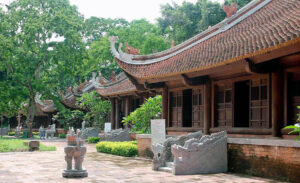 There remain vestiges of the entrance and foundation of the citadel which are found 100 from its front. The foundation is found to stretch to the bank of the Ngoc River, and it is 1.8m thick, 10m from the wall is the Ngoc River, 20m in width. Over it is a curved bridge named Tien Loan, on which there is small house, 50m from the bridge is ancient rectangular water well. Then comes a large yard leading to Ngo Mon Linings along the entrance to the gate are two stone unicorn like animals standing on rectangular platforms. Their bodies are delicately decorated. Their heads raise high forward in a defensive position.
There remain vestiges of the entrance and foundation of the citadel which are found 100 from its front. The foundation is found to stretch to the bank of the Ngoc River, and it is 1.8m thick, 10m from the wall is the Ngoc River, 20m in width. Over it is a curved bridge named Tien Loan, on which there is small house, 50m from the bridge is ancient rectangular water well. Then comes a large yard leading to Ngo Mon Linings along the entrance to the gate are two stone unicorn like animals standing on rectangular platforms. Their bodies are delicately decorated. Their heads raise high forward in a defensive position.
Despite the limited number of vestiges, we can assume that the site must have been a very big structure built by King Le Loi. In this place now still remain several monuments such as Le Thai To Tomb, Vinh Lang stele…
Famous temples
Lady Trieu Temple
 The Lady Trieu Temple is a place to worship the Vietnamese national heroine named Trieu Thi Trinh, who had the merit of repelling the invaders of Dong Ngo (China) in the middle of the 3rd century. The temple was built in the 6th century, established by King Ly Nam De to commemorate the patriotic heroine. She was also the first Vietnamese feudal woman to be deified.
The Lady Trieu Temple is a place to worship the Vietnamese national heroine named Trieu Thi Trinh, who had the merit of repelling the invaders of Dong Ngo (China) in the middle of the 3rd century. The temple was built in the 6th century, established by King Ly Nam De to commemorate the patriotic heroine. She was also the first Vietnamese feudal woman to be deified.
After being destroyed many times during the history of foreign invasions of the nation, the temple was moved to its current location, at the end of the 18th century, the temple began to have the appearance it has today.

Lady Trieu Temple was built according to the traditional architecture of the Northern Delta, with an overall layout from the outside in: Outer gate, rectangular lake, inner gate, left and right wings, sanctum, middle hall and back hall. The special highlight in the sanctum is the ancient stone pillars with quite unique and special architecture.
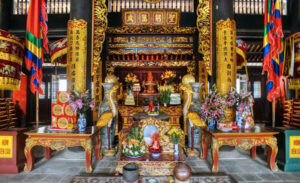 The Lady Trieu Temple Festival is held annually (from the 21st to the 23rd day of the second lunar month) with a strong traditional cultural identity associated with historical legends about Lady Trieu. At the festival, activities will take place such as: worshiping, carrying palanquins, worshiping female officials, worshiping Phung Nghinh… In addition, there are also folk art performances such as: fighting game, folk singing, wrestling, rope climbing, rice cooking competition, and chess playing.
The Lady Trieu Temple Festival is held annually (from the 21st to the 23rd day of the second lunar month) with a strong traditional cultural identity associated with historical legends about Lady Trieu. At the festival, activities will take place such as: worshiping, carrying palanquins, worshiping female officials, worshiping Phung Nghinh… In addition, there are also folk art performances such as: fighting game, folk singing, wrestling, rope climbing, rice cooking competition, and chess playing.
The temple was built on Gai Mountain in Phu Dien Village, Trieu Loc commune, close to National Highway 1, and 137km from Hanoi. Travelers often stopover at the mountain to pay their respects to the heroin and to admire the view.
Le Dynasty Temple
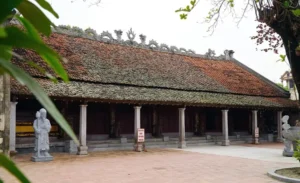 Located 2 km from the ward center, in Hac Thanh ward, the Later Le Dynasty Temple (also known as the Le Dynasty Temple), a place to worship 27 Emperors of the Le Dynasty, the Queen Mother and the Princes of the Later Le Dynasty, including two founding heroes Nguyen Trai and Le Lai.
Located 2 km from the ward center, in Hac Thanh ward, the Later Le Dynasty Temple (also known as the Le Dynasty Temple), a place to worship 27 Emperors of the Le Dynasty, the Queen Mother and the Princes of the Later Le Dynasty, including two founding heroes Nguyen Trai and Le Lai.
The Later Le Dynasty Temple was originally built in Lam Kinh (Tho Xuan district), and was later moved to Thang Long with the name Hoang Duc Palace. In 1805, King Gia Long ordered the transfer of the Later Le Dynasty Temple to Bo Ve village.
 The Le Dynasty Temple was built in the architectural style of the Later Le and Nguyen dynasties, including the Front Palace and the Back Palace, connected by a continuous courtyard. The temple still preserves many original artifacts that are very valuable in many aspects. In particular, there are 6 statues of Emperor Than Tong and his concubines.
The Le Dynasty Temple was built in the architectural style of the Later Le and Nguyen dynasties, including the Front Palace and the Back Palace, connected by a continuous courtyard. The temple still preserves many original artifacts that are very valuable in many aspects. In particular, there are 6 statues of Emperor Than Tong and his concubines.
The Le Temple was granted the title of “National Historical, Cultural and Architectural Relic” by the Ministry of Culture, Sports and Tourism. Coming to the Le Temple, in addition to visiting and learning about the history of the Le Dynasty, visitors also have the opportunity to explore the ancient architecture and typical sculptures of the Later Le Dynasty.
Specialties of Thanh Hoa
Fermented pork roll
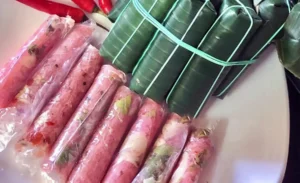 Fermented pork roll or sour pork roll is the most famous specialty of Thanh Hoa, with many types such as long, square, grill… The ingredients for fermented pork roll are thinly sliced pork skin, lean rump, rice bran, wrapped with Polyscias fruticosa leaves or young guava leaves and other spices.
Fermented pork roll or sour pork roll is the most famous specialty of Thanh Hoa, with many types such as long, square, grill… The ingredients for fermented pork roll are thinly sliced pork skin, lean rump, rice bran, wrapped with Polyscias fruticosa leaves or young guava leaves and other spices.
Fermented pork roll is often dipped in chili sauce. The roll has the crunchiness of pork skin, a light sour taste after fermentation, the spiciness of chili and garlic and the sweetness of meat.
Thanh Hoa rice rolls
 Thanh Hoa rice rolls are different from rice rolls in the Northern provinces, because the filling is made from sea shrimp and fried onions. Thanh Hoa people often use bamboo tubes as big as a plow to get the rice rolls instead of thinly shaved bamboo sticks like in other places.
Thanh Hoa rice rolls are different from rice rolls in the Northern provinces, because the filling is made from sea shrimp and fried onions. Thanh Hoa people often use bamboo tubes as big as a plow to get the rice rolls instead of thinly shaved bamboo sticks like in other places.
The Thanh Hoa rice rolls also have many other variations, the most popular is the rice rolls without filling, cut into cylinders, sprinkled with fried onions, eaten hot with fish sauce or with eel porridge, which Thanh Hoa people liken to “twirls” eaten with Hanoi pho. The rice rolls are eaten with local fish sauce and sausage, with added black pepper and chili.
Nga Son eel salad
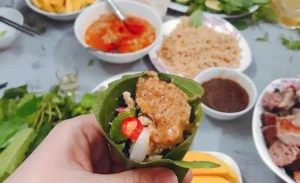 The salad is a Vietnamese salad made with the small fry of the local paddy field eel. This is a specialty of Nga Son region. Eel is a slippery fish with a long, strong and aggressive body, often living in brackish water. After cleaning the slime, peeling off the skin and removing the bones, the meat is squeezed with galangal and lemongrass. When eaten, mix with rice bran.
The salad is a Vietnamese salad made with the small fry of the local paddy field eel. This is a specialty of Nga Son region. Eel is a slippery fish with a long, strong and aggressive body, often living in brackish water. After cleaning the slime, peeling off the skin and removing the bones, the meat is squeezed with galangal and lemongrass. When eaten, mix with rice bran.
The soul of eel salad is the sauce made from crushed fish bones mixed with pork belly, yeast, chicken eggs and spices and cooked. The finished sauce will be orange-red, with a special consistency and flavor. Eels are difficult to catch and the preparation process is elaborate. Thanh Hoa people often roll fig leaves into a funnel shape, put eel salad in, drizzle with sauce, add shallots, rice paper, shrimp paste and enjoy.
Shrimp cake
 Shrimp cake is a rustic dish of Thanh Hoa. The filling is made from fresh crushed shrimp powder, minced pork belly, dried onions and chopped rice noodles, seasoned with spices and gac oil for color.
Shrimp cake is a rustic dish of Thanh Hoa. The filling is made from fresh crushed shrimp powder, minced pork belly, dried onions and chopped rice noodles, seasoned with spices and gac oil for color.
The filling after being pre-processed is wrapped in small rice noodles the size of the palm of the hand, clamped in fresh bamboo splints or placed on a charcoal grill.
Shrimp cake is often eaten with pickled vegetables, raw vegetables and diluted fish sauce. The sweet taste of shrimp filling, the mild sourness of pickled vegetables, and the spiciness of fresh chili and raw vegetables create a new flavor for diners from far away.
Source: collected by An
Follow us for the best deal with Vietnam package tours and visa services!
